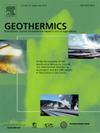Hydrogeochemical characteristics of geothermal springs along the central section of Altyn Tagh fault: Implications for deep fluid circulation and tectonic activity
IF 3.5
2区 工程技术
Q3 ENERGY & FUELS
引用次数: 0
Abstract
Geothermal springs associated with fault systems may offer valuable insights into fluid-rock interactions and crustal processes. However, hydrogeochemical data on the Altyn Tagh fault, a major strike-slip fault bounding the northern Tibetan Plateau, are scarce. In this study, the chemical and isotopic compositions of 29 geothermal springs along the central section of Altyn Tagh fault have been analyzed and the results show the following: (1) The springs are primarily meteoric in recharge source, exhibiting Na-SO4-Cl and Ca-Mg-SO4-Cl type. Calculated circulation depths ranging from approximately c. 135 m to c. 2790 m, indicating a shallow to intermediate hydrothermal system with limited water-rock interaction. Dissolved inorganic carbon (DIC) derives primarily from deep decarbonation and carbonate dissolution. (2) Specifically, the highest reservoir temperatures, deepest circulation, and greatest deeply sourced CO2 flux have been found from the Xorkoli to the Wuzunxiaoer section of the fault. Spatial trends reveal increasing reservoir temperatures, circulation depths, and endogenic DIC fractions with increasing distance from the fault, suggesting the influence of distal, deeper geothermal systems on spring geochemistry. (3) Comparative analysis with other strike-slip faults reveals notably shallower circulation depths along the Altyn Tagh fault, attributable to the combined effects of cold crustal thermal regime, seismic cycle, and moderate topographic relief. Locally enhanced circulation depths occur in distinct sedimentary-hydrogeological conditions and extensional step-overs areas. These findings provide new constraints on the relationship between hydrothermal circulation and fault zone processes, with implications for understanding crustal fluid dynamics along major strike-slip faults.
阿尔金断裂带中段地热泉水文地球化学特征:深部流体循环和构造活动意义
与断层系统相关的地热泉可能为流体-岩石相互作用和地壳过程提供有价值的见解。然而,阿尔金塔格断裂是青藏高原北部的一条主要走滑断裂,其水文地球化学资料很少。本文对阿尔金断裂带中段29条地热泉的化学同位素组成进行了分析,结果表明:(1)泉水补给源以大气降水为主,表现为Na-SO4-Cl型和Ca-Mg-SO4-Cl型。计算循环深度约为c. 135 ~ c. 2790 m,表明该区为浅层至中层热液系统,水岩相互作用有限。溶解无机碳(DIC)主要来源于深层脱碳和碳酸盐溶解。(2)其中,小尔科里至乌尊小二段的储层温度最高,环流最深,深层源CO2通量最大。空间趋势显示,随着离断层距离的增加,储层温度、循环深度和内生DIC分数均增加,表明远端深层地热系统对泉水地球化学的影响。(3)与其他走滑断裂的对比分析表明,阿尔金断裂带的环流深度明显较浅,这是由于地壳冷热状态、地震旋回和地形起伏的共同作用。局部环流深度增强发生在不同的沉积水文地质条件和伸展台阶地区。这些发现对热液环流与断裂带过程的关系提供了新的约束,对理解主要走滑断层的地壳流体动力学具有重要意义。
本文章由计算机程序翻译,如有差异,请以英文原文为准。
求助全文
约1分钟内获得全文
求助全文
来源期刊

Geothermics
工程技术-地球科学综合
CiteScore
7.70
自引率
15.40%
发文量
237
审稿时长
4.5 months
期刊介绍:
Geothermics is an international journal devoted to the research and development of geothermal energy. The International Board of Editors of Geothermics, which comprises specialists in the various aspects of geothermal resources, exploration and development, guarantees the balanced, comprehensive view of scientific and technological developments in this promising energy field.
It promulgates the state of the art and science of geothermal energy, its exploration and exploitation through a regular exchange of information from all parts of the world. The journal publishes articles dealing with the theory, exploration techniques and all aspects of the utilization of geothermal resources. Geothermics serves as the scientific house, or exchange medium, through which the growing community of geothermal specialists can provide and receive information.
 求助内容:
求助内容: 应助结果提醒方式:
应助结果提醒方式:


